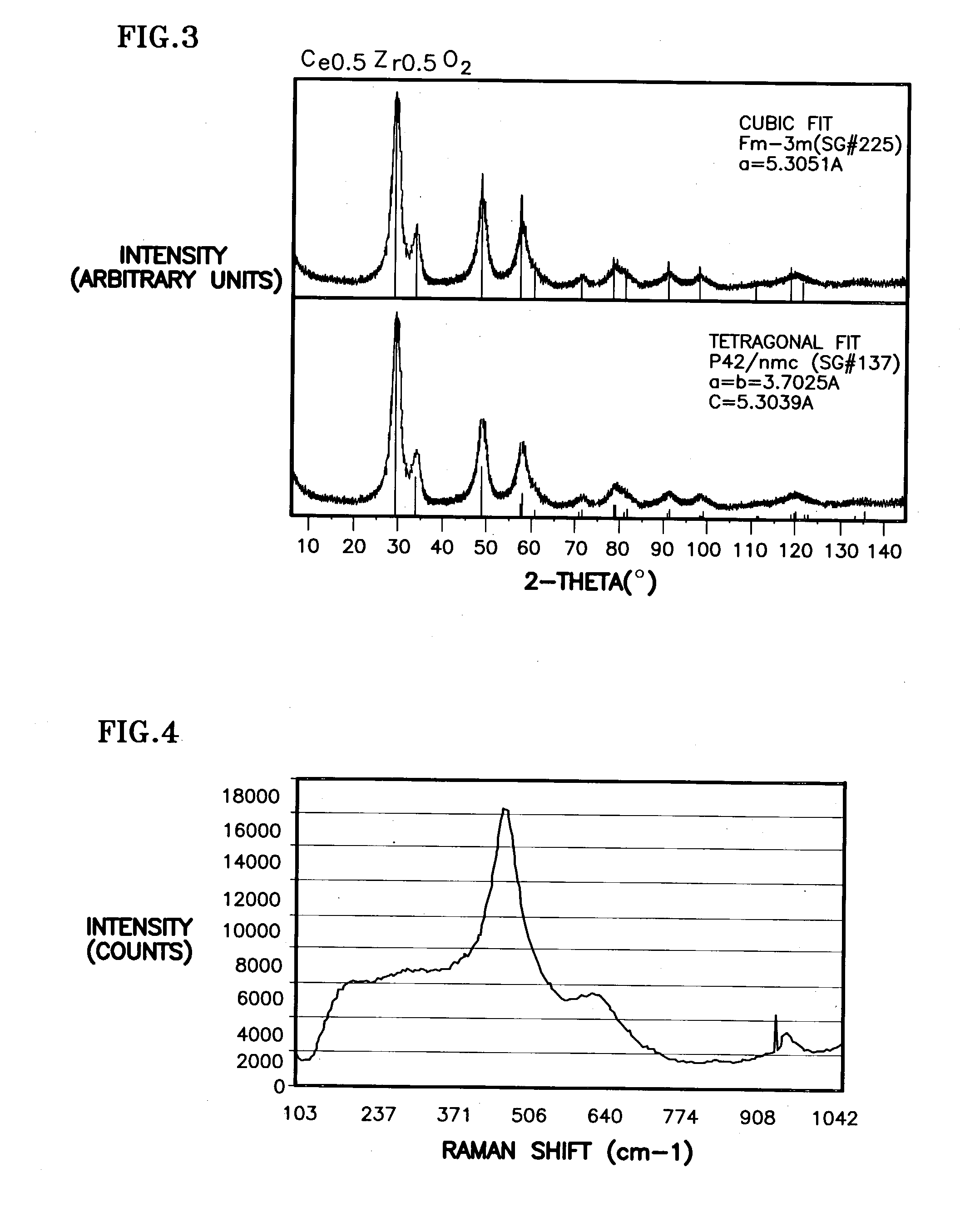Ceria-based mixed-metal oxide structure, including method of making and use
a mixed metal oxide and mixed metal technology, applied in the direction of physical/chemical process catalysts, catalyst carriers, bulk chemical production, etc., can solve the problems of limiting the catalytic or gettering action in a given reactor volume, reducing the value of catalysts, and less desirable catalysts for fuel processing systems. , to achieve the effect of short aging, no aging, and no aging
- Summary
- Abstract
- Description
- Claims
- Application Information
AI Technical Summary
Benefits of technology
Problems solved by technology
Method used
Image
Examples
example 4
[0073] The following is an example demonstrating a ternary mixed metal oxide in accordance with the invention where the dopant is a rare-earth metal. A Ce.sub.0.625Zr.sub.0.325PrO.sub.2 catalyst support (Sample UR26) was prepared as described in Example 1 with the modification that the amount of (NH.sub.4).sub.2Ce(NO.sub.3).sub.6 and ZrO(NO.sub.3).sub.2 used was 25.7 g and 6.7 g, respectively, and 1.63 g of Pr(NO.sub.3).sub.3.6H.s-ub.2O was also added to the solution. After calcination, the surface area of the support is 182 m.sup.2 / g, the pore volume is 0.26 cm.sup.3 / g, and the average pore diameter is 56 .ANG. (5.6 nm).
example 5
[0074] The following is an example demonstrating yet another ternary mixed metal oxide in accordance with the invention where the dopant is a rare-earth metal. A Ce.sub.0.625Zr.sub.0.325La.sub.0.05O.sub.2 catalyst support (Sample UR37) was prepared as described in Example 4 with the modification that 1.62 g of La(NO.sub.3).sub.3.6H.sub.2O was used instead of the 1.63 g of Pr(NO.sub.3).sub.3.6H.sub.2O, and the resulting extrudates were calcined at 450.degree. C. instead of 500.degree. C. After calcination, the surface area of the support is 204 m.sup.2 / g, the pore volume is 0.25 cm.sup.3 / g, and the average pore diameter is 49.9 .ANG. (4.9 nm). The average crystallite size is 28.6 .ANG. (2.86 nm).
example 6
[0075] The following is an example demonstrating a ternary mixed metal oxide in accordance with the invention where the dopant is a non rare-earth metal. A Ce.sub.0.7Zr.sub.0.22Nb.sub.0.08O.sub.2 catalyst support (Sample UR84) was prepared as described in Example 1 with the modification that the amount of (NH.sub.4).sub.2Ce(NO.sub.3).sub.6 and ZrO(NO.sub.3).sub.2 used was 28.8 g and 4.54 g, respectively, and 7.94 g of niobium oxalate was also added to the solution. After calcination, the surface area of the support is 152 m.sup.2 / g, the pore volume is 0.24 cm.sup.3 / g, and the average pore diameter is 64 .ANG. (6.4 nm).
PUM
| Property | Measurement | Unit |
|---|---|---|
| pore diameters | aaaaa | aaaaa |
| pore diameters | aaaaa | aaaaa |
| pore diameters | aaaaa | aaaaa |
Abstract
Description
Claims
Application Information
 Login to View More
Login to View More - R&D
- Intellectual Property
- Life Sciences
- Materials
- Tech Scout
- Unparalleled Data Quality
- Higher Quality Content
- 60% Fewer Hallucinations
Browse by: Latest US Patents, China's latest patents, Technical Efficacy Thesaurus, Application Domain, Technology Topic, Popular Technical Reports.
© 2025 PatSnap. All rights reserved.Legal|Privacy policy|Modern Slavery Act Transparency Statement|Sitemap|About US| Contact US: help@patsnap.com



